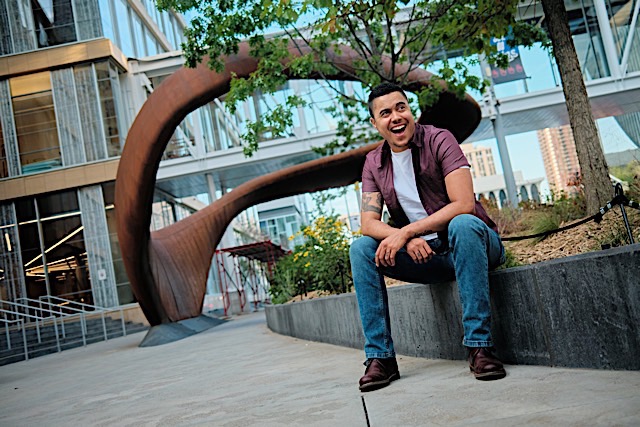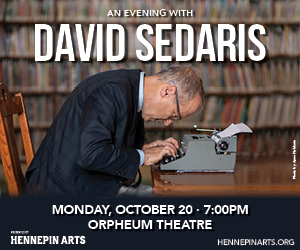Channeling That Inner Fire

Fire. There’s something magical, primal about it—the foremost element, the impetus for humans taking that first important step into civilization. The ancient Greeks said that the Titan Prometheus stole fire from the gods to give to humans, and that it was considered one of the most precious and valuable gifts given, coveted by the Olympians who thought it only worthy of the immortals.
Metal is equally potent—the element that elevated humans from relying on simple stone tools, and allowed them to create pieces that were both beautiful and deadly.
Flickering flames, the slow march of bubbling lava, the radiating waves of heat from desert sand, the sinuous flow of molten steel…it can be mesmerizing to watch, to lose yourself in its power and magnetism. Equally mesmerizing is talking with someone whose passion in life involves blending those ancient elements of fire and metal.

Seven Bailey—metal fabricator, artist, welder—has that passion, and it shows in their creations and collaborations, two of which can be seen right here in Minneapolis. Seven helped in the construction of artist Tristan Al-Haddad’s massive 10-ton sculpture Nimbus, which is currently in place above Nicollet Mall’s Theater in the Round, located in front of the Minneapolis Central Library. Another collaborative sculpture is entitled Purple Raindrop, which was inspired by Prince’s Purple Rain. Twin Cities visual artist and Phillips neighborhood resident Esther Osayande designed the seductively curving metal piece, and Seven, along with fellow female welder Heather Doyle, brought it to life in steel.
I spoke with Seven about their path in life, and how it’s led to becoming part of the new Netflix competition series Metal Shop Masters, in which a select group of metal artists cut, torch and weld steel creations in hopes of walking away with the $50,000 grand prize.
Where did you grow up, go to school? We’d love to get some background on you for our readers who don’t know you, or don’t know you well.
I grew up in Winona, MN. I attended school at Winona Senior High and graduated in ’99. I had three passions as a teen: karate, film and art. I focused mostly on mixed media but really dove into photography and film as a senior. After I graduated, I attended St. Mary’s University, where I majored in Studio Art with an emphasis on metal sculpture. I was dealing with a broken heart at the time—I had just lost my first love to a tragic car accident. I had a difficult time applying myself to basic studies, so I dropped out after my first year. I firmly believed at the time that it was what was needed for me to grow, and that if I were to be an artist, I wouldn’t need a degree to accomplish it.
Did you always want to go into the field of welding as a career? What piqued your interest in this vocation?
I was an only child for most of the time I was growing up, and I was always entertaining myself. I found that drawing, painting, and building things brought me joy. There were a few pivotal moments that I believe contributed to my love of welding; these moments also helped me to open my eyes and learn more about what it meant to be young and queer.
The first moment was seeing the movie Flashdance as a kid. I remember being so fascinated by the raw sexuality in the movie, and seeing how unapologetic Alex was about taking up space after really coming into her own. It wasn’t just that she was able to take up space as a woman welder in a male-dominated industry; it was also that she was able to be seen as a biracial woman in the very white world of professional dance. It was owning her art and body while working in the club, showing a side of sex work that many had not seen. Of course, the movie is very dated and has flaws, but as a kid, there were so many things that I wanted to know and do after watching it. I always say that my life has imitated art, since I’m a Black welder who happens to be married to a burlesque performer and a very proud sex worker.
The second moment relating to my queer roots (at this point I feel like I’m giving you six degrees of separation surrounding the impact of film and my queerness) was when Bound came out in 1996, and I was 15 years old. The character Corky had the worst name, but embodied all that I wanted to be. So I started moving into my butch identity and became fascinated by all things Gina Gershon, including this noir movie called Palmetto, in which she portrayed a metal artist. I think it was at that point I thought, This is it: I can weld, do art and be queer.

You’ve done several large metal art pieces. What prompted or led you towards the artistic side of metal work?
That would be me meeting the person I lovingly refer to as my “work wife,” Heather Doyle. She is the Artistic Director of the Chicago Avenue Fire Arts Center (CAFAC) and the founder of Industryelle, a group that collaborates on metal art here in the Twin Cities. I had been working as a welder and fabricator for almost 10 years when we met. I asked if she needed help with anything and she brought me in on a project. We’ve been together ever since. We complement one another so perfectly—she’s about vision, movement and fluidity, and I lean towards precision, functionality and the overall execution of things. I believe it’s been her artistic vision—which really highlights the impact of metal art—that has truly inspired, shaped and motivated me.
Do you still teach at Dunwoody? What do you love about teaching, or getting prospective students interested in the field?
I no longer teach at Dunwoody, but I do teach advanced fabrication classes at CAFAC. Teaching has a big part of my heart; I love sharing knowledge about welding and fabrication with others. It’s a gift to possess these skills, and I firmly believe in sharing them to empower others to make them their own. Welding and metal fabrication has given me a beautiful career path that continues to evolve. It’s bigger than just being a welder. My path has gone from welder, to manager, instructor, welding inspector, artist, and back again. Now it’s 2021 and I’m about to be on Netflix! I couldn’t have predicted that. I can say, however, that I plan on continuing to use any platform I have to share this world, and my experience, with others. I remain focused on reaching marginalized folx. There are endless opportunities in the world of metal, and the more visible we all are, the more we can reach out and support one another.
How did you get chosen for Metal Shop Masters? Did you apply, or were you nominated by someone?
I was contacted by a producer, and to this day, I have no idea how they found out about me or why they asked me to be a part of the show. I originally wanted to turn the opportunity down. I had to sit with what me being on the show represents. To me, it’s important to be visible. I haven’t seen many Black, trans, non-binary queers in the welding world—let alone on TV. It’s important for us to keep taking up space, sharing our experiences, and to keep on shining. I definitely did it for the culture.

I often watch Forged In Fire, and enjoy seeing the camaraderie between the competitors, as opposed to, say, the backstabbing on shows like Survivor. They genuinely seem to get along, and don’t take pleasure in watching a competitor’s project break or not make the cut. Did you find that there was a lot of support between competitors on Metal Shop Masters, even though everyone is ultimately hoping to be the winner?
I had the opportunity to meet six people who I now get to call my family. We all have different backstories and experiences in the industry, and we’re still all on a group chat.
I most recently met up in Alabama with badass Leah Aripotch to work on the Mothers of Gynecology Monument (https://www.anarchalucybetsey.org), which was created by artist Michelle Browder. It was an absolute gift to be able to collaborate with an artist of Leah’s caliber. While we were down there, our brothers from the show met up with us, as they were also collaborating on a project down in Louisiana. I think it’s so wonderful that the show brought us together and that we became family to one another. I love that we continue to connect and create together.
You’ve worked on two very socially and culturally significant pieces; one here in the Cities, and one down in Alabama. Tell me about those, and what your involvement in helping to bring them to fruition meant to you.
I don’t seek these projects; they tend to find me. Systemic abuse, and murder of Black and Indigenous people is happening every single day. It’s important to have a voice now more than ever—this generation refuses to stay silent about the social injustices of BIPOC history and the modern day experience in the U.S. Art is a constant visual reminder of that; where we were, where we are, and where we are going. For example, in Alabama there’s a statue in front of their capital building of James Marion Sims. Sims is celebrated as the “Father of Modern Gynecology”; people don’t realize that he tortured enslaved women by performing crude experiments on them without anesthesia. Sims would then offer the procedure to wealthy white women who were sedated. Artist Michelle Browder had heard of my work and reached out to me for help bringing a more fitting monument to Montgomery in response to the real truth behind what Sims did. She lovingly titled them “The Mothers of Gynecology.” In July, I took a team of women down there to give body and face crafted from donated metal and gynecological instruments to these women. People will see this monument and hopefully bring light to Anarcha, Lucy and Betsey, who are the epitome of resilience—they were Black women who will not be forgotten.

At home I was reached out to help re-create the fist in George Floyd Square (GFS) that Jordan Powell-Karis created during the uprising. The community felt there was a need to construct it out of something that could not be burned—obviously metal was the clear choice. I had a little over a week to assemble a team and start fabrication, as we were to do the install on MLK Day. Once I had a full team of volunteers we worked together to get it done in just four days. The GFS community then came together and erected it within 40 minutes from start to finish. It is still standing, as we’re still asking for a list of demands to be met. It will continue to be there as it is the “Heart” of the square.
I’ll continue to use my skills to bring important stories to light, support my community, create healing spaces and share the beautiful world of metal fabrication. My mission in life is to support and empower others—metal art just happens to be my vessel.
What advice would you give to a person who’s interested in making metal work and welding a vocation—either in the technical field or the artistic field?
NETWORK! Building a strong network of humans really helps shape the world you want to cultivate around you. Grab onto opportunities that speak to you, and don’t pass up opportunities out of fear.
If you’re interested in getting into the world of welding, art, or both, please feel free to reach out to me! Check out Dunwoody College of Technology if you’re interested in going the academic route. If you’re leaning towards art, stop by the Chicago Avenue Fire Arts Center and get connected with an amazing community of educators and artists ready to share the gifts of heat, spark and flame with metal.
5200 Willson Road, Suite 316 • Edina, MN 55424
©2025 Lavender Media, Inc.
PICKUP AT ONE OF OUR DISTRIBUTION SITES IS LIMITED TO ONE COPY PER PERSON



